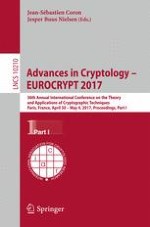The three-volume proceedings LNCS 10210-10212 constitute the thoroughly refereed proceedings of the 36th Annual International Conference on the Theory and Applications of Cryptographic Techniques, EUROCRYPT 2017, held in Paris, France, in April/May 2017.
The 67 full papers included in these volumes were carefully reviewed and selected from 264 submissions. The papers are organized in topical sections named: lattice attacks and constructions; obfuscation and functional encryption; discrete logarithm; multiparty computation; universal composability; zero knowledge; side-channel attacks and countermeasures; functional encryption; elliptic curves; symmetric cryptanalysis; provable security for symmetric cryptography; security models; blockchain; memory hard functions; symmetric-key constructions; obfuscation; quantum cryptography; public-key encryption and key-exchange.
